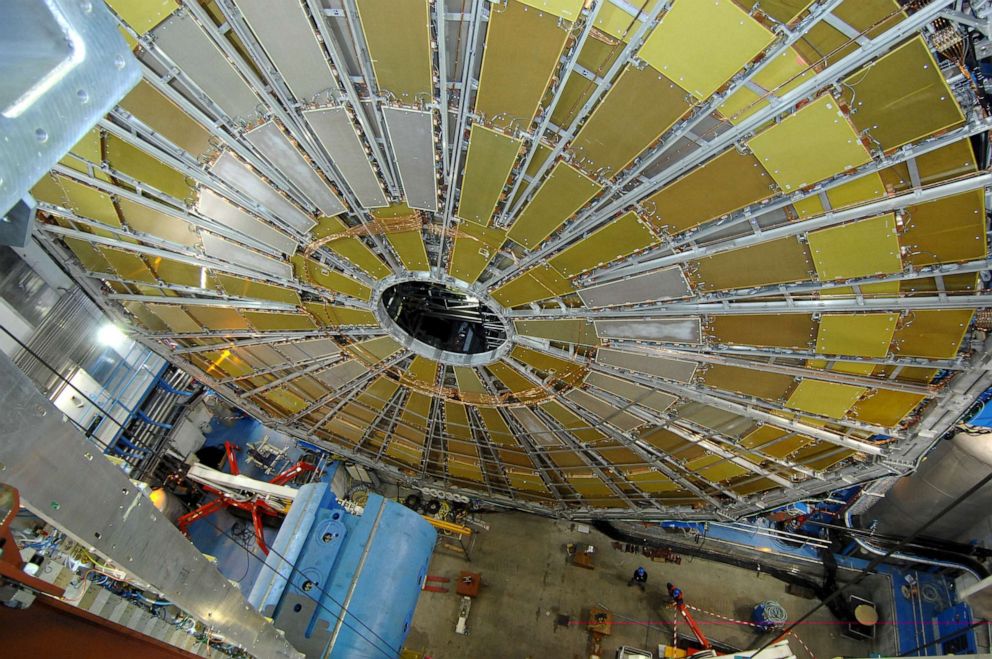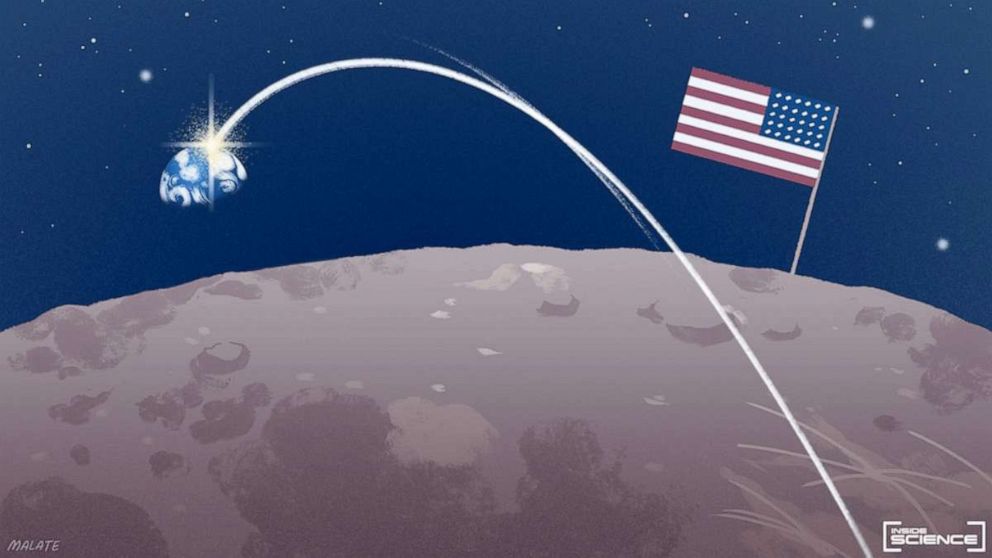What a modern moonshot would look like
This is an Inside Science story.
(Inside Science) -- A half century ago this July, Neil Armstrong and Buzz Aldrin stepped outside the Eagle lander and set foot on the moon, the first time humans ever walked upon the dusty, pockmarked surface of our lunar neighbor.
Looking back, it’s clear that whatever American astronauts and engineers lacked in space infrastructure and necessary scientific advances while putting together their historic mission, they made up for with massive public support, government funding, and chutzpah.
“It was an incredible achievement,” said Neal Lane, a senior fellow in science and technology policy at Rice University’s Baker Institute for Public Policy. The feat was especially remarkable given how quickly NASA had to develop the knowledge, technology and institutional capabilities needed to complete the mission, he said.
Today, President Donald Trump, Democratic presidential hopefuls, government agencies and some big and forward-thinking companies all have their sights set on their own so-called moonshot projects, some of which have nothing to do with space.
Such branding tries to capitalize on the special feel of the original mission. “‘Moonshot’ has a ring to it. It stimulates positive thinking,” said Lane.
Yet it's impossible to recreate the unique historical conditions of the space race. Can we develop a new recipe for how to assemble all the right ingredients -- or “the right stuff” -- to see a 21st century moonshot come to fruition?
The Cold War ignites a heated race
For the original moonshot in the 1960s, former President John F. Kennedy repeatedly called for “landing a man on the moon and returning him safely to the Earth” before the decade was out -- including in a famous speech at Rice University. Lane points out that there’s more behind the success of Apollo 11 than Kennedy's personal push for it: Kennedy himself acknowledged in later speeches that the ambitious goal of a moon landing stemmed from NASA being on the losing end of the space race with the Soviet Union. That helped overcome resistance among some Congress members about the moon program’s price tag.
“We would not have gone to the moon had it not been for the Cold War,” Lane said. The space program was developed as a peaceful, civilian program, but that didn’t make the competition between NASA and its Soviet rival feel any less real.

In a different political and economic situation today, the Trump administration wants to return astronauts to the moon by 2024 for the first time since the Apollo missions. Trump’s “Moon to Mars” program, recently renamed Artemis, includes completing the Space Launch System -- the biggest rocket ever made -- as well as the new Orion space capsule and a proposed space station in orbit around the moon. He then wants to continue with NASA’s increasingly unrealistic goal of sending astronauts to the red planet -- more than 140 times as far away as the moon -- within 20 years. But he lacks broad political support.
“The geopolitical climate was different then than today,” said Steven Clarke, NASA’s Deputy Associate Administrator for Exploration. But he says that NASA’s going to be “able to pick up where we left off, building on the technical and scientific accomplishments back then.” If Artemis’s astronauts indeed land on the moon -- which might depend on mustering political support for the mission after Trump leaves office -- they’ll want to determine whether water ice concentrated on the moon’s south pole can be easily extricated and broken down into drinking water and hydrogen fuel for rocket engines.
NASA’s not the only player with designs on the moon -- the European Space Agency as well as Chinese, Russian, Japanese and other space agencies all have their own moon missions in progress. Many commercial space companies have plans as well, including SpaceX and Blue Origin, which last month announced its Blue Moon lander, capable of transporting rovers and other large payloads, possibly for NASA’s 2024 mission. (Blue Origin declined interview requests for this article.) But despite NASA’s many rivals in this new moon race, Clarke describes the current situation as “more collaborative than competitive.”
One reason why that lost competitive spirit was so important to the original moonshot is that it helped secure federal money for the project. Today, NASA’s fraction of the federal budget remains stagnated at one-tenth Apollo levels.
“What characterizes a moonshot is the resources, not the big goals,” said Matt Hourihan, director of the R&D Budget and Policy Program for the American Association for the Advancement of Science.
Beyond the moon
While crewed space exploration remains a huge challenge without Cold War-level rivalry, other big scientific challenges -- like understanding humanity's genetic code or finding fundamental new particles -- have also captured high levels of public attention and government money. These are the characteristics that have emerged as the qualities of a modern moonshot: lots of funding and public support that pushes a field into completely new frontiers.
For example, the Human Genome Project and Large Hadron Collider, both launched in the 1990s, became massive, historic achievements. The Human Genome Project, in particular, was a new kind of player in the moonshot game. While physics and the space sciences are no strangers to megaprojects, it’s much rarer in biomedical research. Nonetheless, after years of work and billions of dollars, scientists successfully mapped all the genes in the human genome. Two decades later, scientists now have the wherewithal and audacity to explore editing the genome. The European LHC, meanwhile, made possible the discovery of the Higgs boson, an achievement which was awarded a Nobel Prize in 2013. The machine continues to fuel cutting-edge particle physics research today.

Still, “big science” projects and big ideas have no guarantee of success. The Human Genome Diversity Project, intended to study genetic variations of small, remote populations like Native American tribes and Kurds in Turkey, was scuttled when indigenous rights activists resisted the project with concerns about being exploited. And the U.S.-led Superconducting Super Collider, intended to become a particle accelerator in Texas surpassing the LHC, became an expensive failure when Congress members who worried about the government’s budget deficits voted against its continued funding before construction was complete.
And the deficits are even larger today.
A recipe book for changing times
Some government agencies have been reliably funded despite tightened budgets.
The Defense Advanced Research Projects Agency, for example, has produced multiple groundbreaking ideas. DARPA’s successes include research that led to the internet and GPS. Still, the agency has had costly busts as well, including research on psychic spies and work on laser weapons and particle beams that could be used for missile defense.
It’s a risky bet to predict the next big thing, but Safi Bahcall, author of the book “Loonshots,” argues that organizations and agencies must take those risks to make truly innovative leaps.
“When Kennedy declared the goal of putting a man on the moon, he was applauded, but the idea that got us there, which was liquid-fueled propulsion, was suggested 40 years earlier by Robert Goddard and was ridiculed at the time,” he said.
In addition to coming up with big and transformative ideas, a potential moonshot needs reliable funding. To have a shot at government investment in R&D, it helps to spread the benefits around, like NASA does. The space agency has research centers and facilities around the country, as well as contractors and subcontractors that benefit from its myriad missions.
Some private companies have even begun leading their own moonshots. For instance, Google founded X, which bills itself as “the moonshot factory.” The company says it focuses on developing technological breakthroughs to solve huge problems. And their process includes evaluating proposals to weed out fantastical ideas that would never get off the ground. X’s successes include Project Loon, which uses stratospheric balloons to bring internet connectivity to remote or disaster-stricken areas like post-hurricane Puerto Rico.
If research by DARPA and X are a guide, the next moonshots might involve artificial intelligence or robotics or both. Or maybe threats of climate change will inspire game-changing clean energy or negative emission technologies. Or maybe scientists will finally bring fusion energy found in the burning, churning bowels of the sun to the surface of the Earth.
The one thing we'll never be short on is challenges that require the next big leap for humankind.
Inside Science is an editorially-independent nonprofit print, electronic and video journalism news service owned and operated by the American Institute of Physics.





